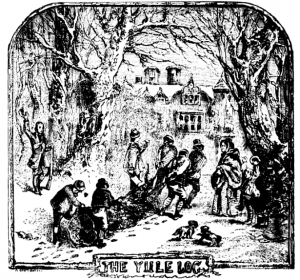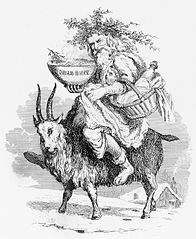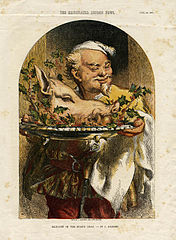 The days draw progressively shorter in the Northern Hemisphere until Winter Solstice on December 21st. As you might imagine, there are a number of traditions associated with this event that subsequently became part of the Christmas holiday celebration. Here’s a brief overview of Yule celebrations of past and present.
The days draw progressively shorter in the Northern Hemisphere until Winter Solstice on December 21st. As you might imagine, there are a number of traditions associated with this event that subsequently became part of the Christmas holiday celebration. Here’s a brief overview of Yule celebrations of past and present.
ANCIENT CELEBRATIONS
The Norse god Odin was part of Yule celebrations that took place for three nights after the solstice. During the feasts, the first toast went to Odin to grant victory and power to the king, the second to Njoror and Freyr for good harvests and peace, and the third for the king. Presumably drinking and toasting went on for much of the night.
The custom changed in the Tenth Century when Haakon Haraldsson, known as Haakon the Good, became king. Haakon grew up in Anglo-Saxon England, and returned to Norway as a Christian, a fact he kept secret until he became secure on his throne, at which time he passed a law saying Yule celebrations would coincide with Christmas when everyone was supposed to drink ale and keep the day as long as the ale lasted.
This merging of holidays may be why Google defines Yuletide as an archaic term for Christmas.
 Now that mystery is solved, other Christmas customs and terms make sense. There is the YULE LOG — not the cake but the specially selected tree brought into the house to be burnt. Yule logs predate Victorian Christmas trees by several centuries. The largest part of the tree was fed into the hearth, with the remainder filling the room. Revelers kept feeding the log into the hearth so it would burn for the entire Twelve Days of Christmas.
Now that mystery is solved, other Christmas customs and terms make sense. There is the YULE LOG — not the cake but the specially selected tree brought into the house to be burnt. Yule logs predate Victorian Christmas trees by several centuries. The largest part of the tree was fed into the hearth, with the remainder filling the room. Revelers kept feeding the log into the hearth so it would burn for the entire Twelve Days of Christmas.
There is also the YULE GOAT, probably  connected to Norse celebrations for the god Thor who traveled the sky in a chariot pulled by two goats. From this beginning, several customs emerged. In Norway people went door-to-door dressed like goats to sing carols in exchange for food and drink.
connected to Norse celebrations for the god Thor who traveled the sky in a chariot pulled by two goats. From this beginning, several customs emerged. In Norway people went door-to-door dressed like goats to sing carols in exchange for food and drink.
In Sweden, Norway, and Finland elves rode goats to deliver gifts to children.
When Scandinavians migrated to America, they brought Yule Goats, most often now viewed as Christmas decorations plaited with straw and tied with ribbons.
The YULE BOAR is another pagan custom we’ve incorporated. Yule Boars probably began with the Anglo-Saxons. On Yule Eve the best boar in the herd was brought into the Banquet Hall. Participants laid their hands on it and made unbreakable oaths which were thought to go straight to Freyr, god of Yule and fertility.
 The next day, the boar was sacrificed to Freyr. Servants carried the boar’s head with the apple in its mouth into the banquet hall to the sounds of trumpets. And the feast began.
The next day, the boar was sacrificed to Freyr. Servants carried the boar’s head with the apple in its mouth into the banquet hall to the sounds of trumpets. And the feast began.
Some say this custom explains why many people eat ham on Christmas Day.
The last Yule custom for today is YULE SINGING better known as WASSAILING. Wassail itself is a beverage made from mulled ale, curdled cream, roasted apples, eggs, cloves, ginger, nutmeg, and sugar. The hot mixture is served from large bowls. As the drinks are passed around, the giver says, “Waes Hael” which translates as Good Health.
If you want to make your own Wassail, here’s one recipe.
Wassailers sound a bit like Norwegian carol-singing goats. Wassailers also go door-to-door singing in hopes they will be asked inside for a bit of wassail, a bite to eat, and some time by a warm fire. In Victorian times, Wassailers morphed into people going door-to-door singing Christmas carols.
So now you know how St. Nicholas became Santa Claus; how Yule became Christmas; how Yule Boars became Christmas ham, and how Wassailers turned into Carolers. I don’t know how the Yule Log became a round cake. I’ll try and find out for next year.
In the spirit of Christmas silliness, I’ve attached a humorous rendition of “Here We Come A-Wassailing.”
HAVE A WONDERFUL CHRISTMAS, AND I’LL BE BACK NEXT MONTH.
???
Illustrations in the Public Domain from Wikimedia Commons.
Christmas Tree
Hauling in the Yule Log for Christmas. 1864.
Father Christmas on a Yule Goat.
Boar’s Head on a Platter. 1855
History of the Yule Log. Why Christmas.com
History of Wassailing and Mumming. Why Christmas.com
Slaughtering the Sacred Boar. Yule-the Midwinter Festival. Orkneyjar.
Mark Mancini. The Fiery History of Scandinavia’s Yule Goat. Mental Floss. Dec. 19, 2013.
Sue Weaver. The Yule Goat. Inside Story, Dec. 18, 2009.

Sandra Wagner-Wright holds the doctoral degree in history and taught women’s and global history at the University of Hawai`i. Sandra travels for her research, most recently to Salem, Massachusetts, the setting of her new Salem Stories series. She also enjoys traveling for new experiences. Recent trips include Antarctica and a river cruise on the Rhine from Amsterdam to Basel.
Sandra particularly likes writing about strong women who make a difference. She lives in Hilo, Hawai`i with her family and writes a blog relating to history, travel, and the idiosyncrasies of life.


Love a good wassail! And I enjoy learning about yuletide traditions.
Merry Christmas and a Happy New Year Sandra.
Mulled wine is also nice on a chilly night. Happy Christmas to all.